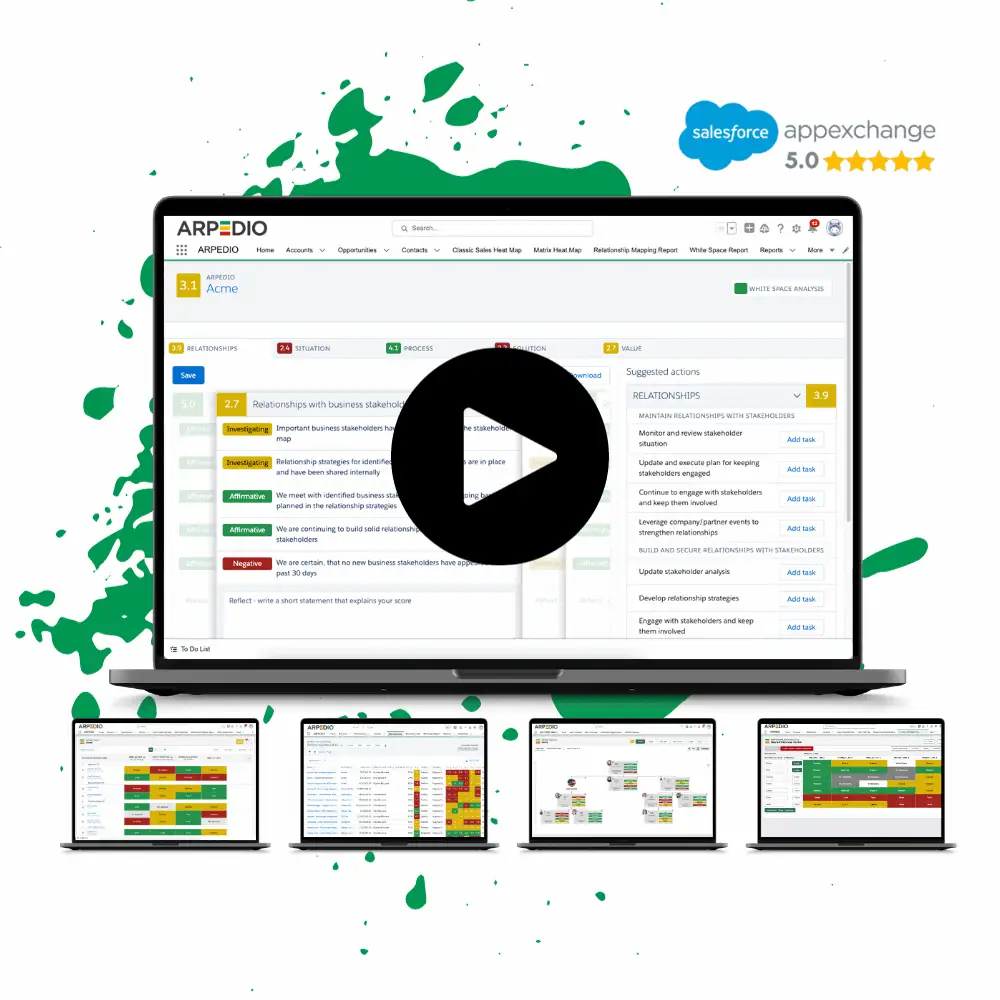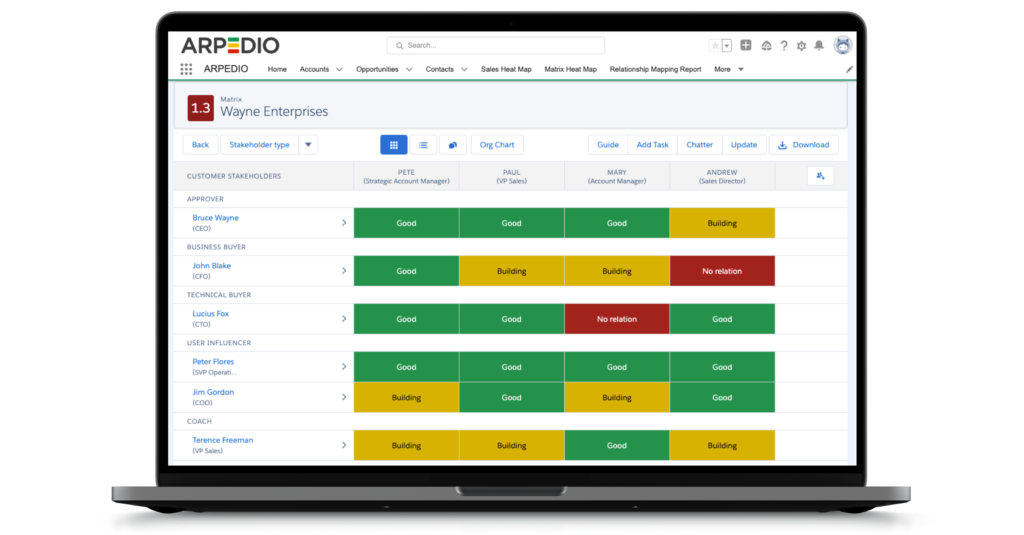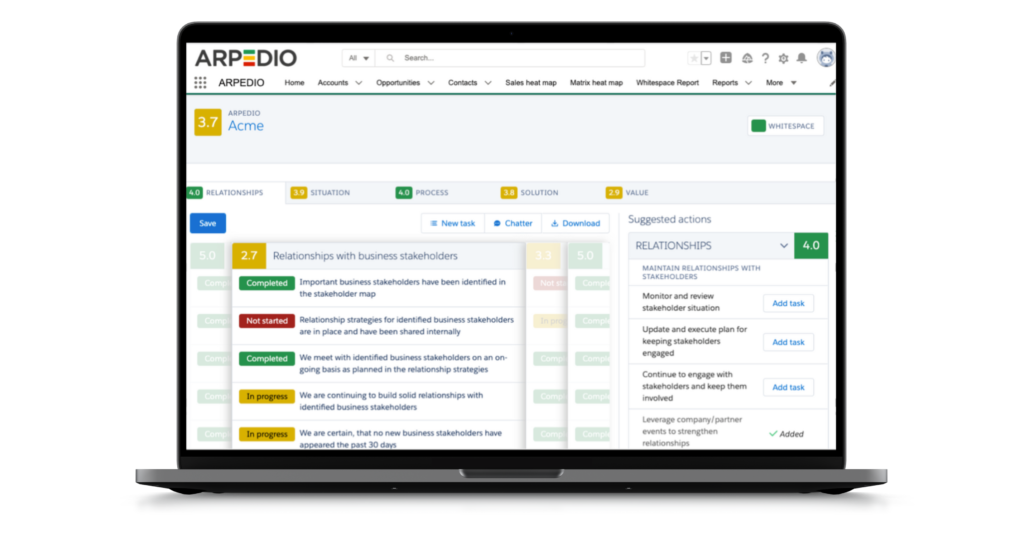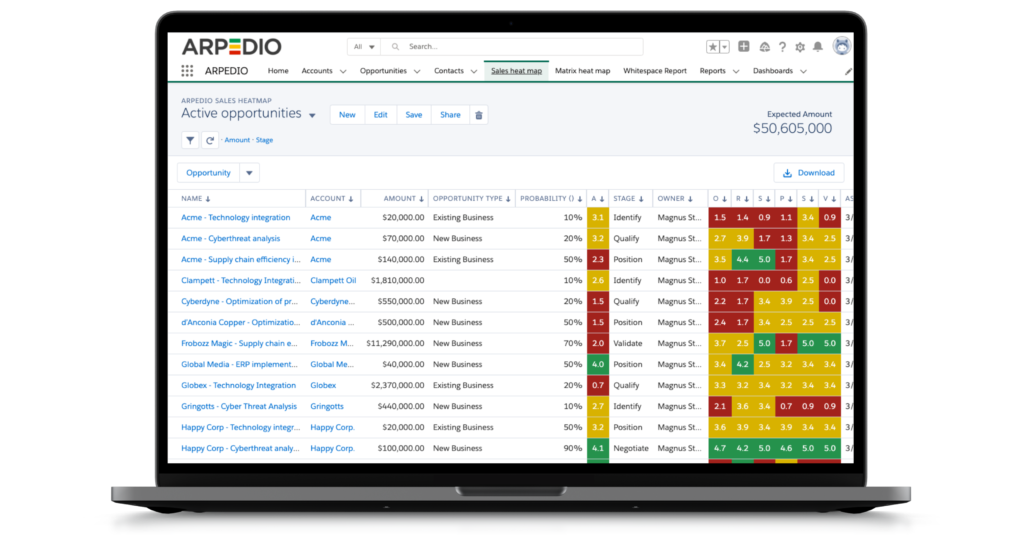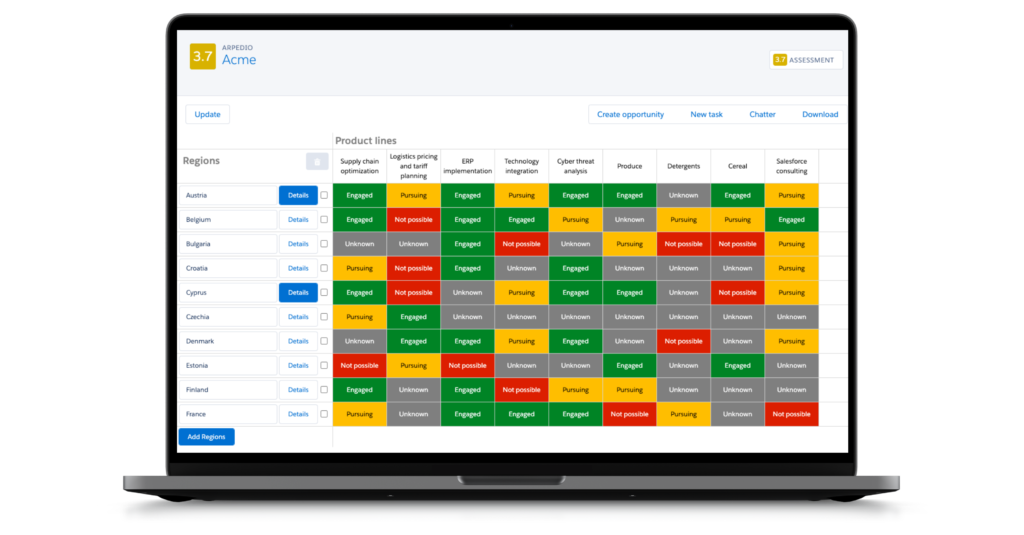Sales pipeline management is an effective tool for converting leads into sales. It provides you with a visual representation of the different stages of the sales process, such as when a lead qualifies as an opportunity, or when it’s time to reach out to a prospective customer. To successfully manage your sales pipeline, you need to consistently feed it with data inputs and review your processes and KPIs on a regular basis. This article will unpack everything sales leaders and sales reps need to know about sales pipeline management.
Table of Contents
What is Pipeline Management in Sales?
Running a business doesn’t come without surprises. That’s why having a reliable indicator of expected business performance can be a big help – both in terms of revenue forecasting, planning for growth, and being prepared for anything lurking around the corner.
And one tool that is really great for estimating incoming revenue is–yes, you guessed it–the sales pipeline!
In short, pipeline management is the process of tracking and managing your sales opportunities as they progress through the different stages of the sales process. This includes everything from
identifying and qualifying leads, to tracking touchpoints and communications with prospects, to forecasting potential sales, to finally analyzing data to make your sales process even more efficient. The overall goal of sales pipeline management is to increase your deal closing probability and get your reps to perform to the best of their ability.
Carefully managing your sales pipeline can provide you with an accurate forecast of how much revenue you can expect to make from your current sales opportunities. It also helps sales leaders and reps organize and track prospects and see how potential deals are progressing against their monthly, quarterly, or annual targets.
Besides giving you a real time view of your sales pipeline, pipeline management tools allow you to filter your pipeline by sales rep, team, territory, etc., for tailored insights into your business. Finally, a pipeline management tool can help you identify and troubleshoot issues in your sales process.
Pipeline Management Definition
Pipeline management refers to the process of tracking and managing the progression of potential sales opportunities as they move through the different stages of the sales process.
What is a Sales Pipeline?
Let’s take a step back and determine what a sales pipeline is before we dive further into the topic of pipeline management. A sales pipeline–sometimes also referred to as a CRM pipeline– is a visual representation of the steps or stages in your sales process that a potential customer moves through as they close in on the final signature. In other words, a sales pipeline is a visual snapshot of where a prospect is in the sales process. A sales pipeline shows you the number of deals your salespeople are expected to seal in a given period of time (week, month or year), and thus gives you a pretty good idea of how much revenue is estimated to come in, and when. This way, a sales pipeline also indicates if your sales reps are reaching their sales quota or not.
Sales Pipeline Example
Let’s say you have a pipeline worth $250,000 in (potential) contract value and your conversion rate (from lead to sale) is 10%, then you can expect to close $25,000 in new business.
However, if your sales target is $50,000, you’ll need to convert twice the amount of leads.
And this is where pipeline analysis comes in handy: If you’re able to ID areas of improvement within your sales pipeline that can help you progress more prospects from one stage to the next, you’ll inevitably be more successful in your job.
What is a Pipeline Analysis?
Pipeline analysis is evaluating why a particular contact succeeds or fails in the last set of activities before closing a sales deal.
Sales Pipeline Stages
Every stage of the pipeline includes one or more actions that a prospective customer has to complete before they can move on to the next one. Usually, these actions are visually portrayed directly in your CRM (if you’re using one).
The pipeline stages typically include more or less variants of the following:
The above 8 bullets are Salesforce’s out-of-the-box opportunity stages. However, these are fully customizable and will vary from business to business.
Every company has their own sales process–and even products within the same company can have their own sales process as well. Therefore, your sales pipeline needs to reflect your unique customer journey.
Whichever stages that make up your sales process, a sales pipeline will help you easily manage prospects and predict revenue based on past behavior, such as conversion rate, average contract value and average sales cycle length, etc.
This is important because studies show that the more transparency you have in your sales pipeline and the more ownership you take, the more revenue you can expect to generate. Bottom line, to grow a strong sales pipeline requires attentive pipeline management.
With a carefully planned customer journey, sales professionals can forecast expected revenue by simply looking at what stage opportunities are in and anticipate how and when they will close as–hopefully–new contracts.
Why is Pipeline Management Important?
We’re all looking for ways to grow our revenue, right? And that’s exactly what should be your biggest incentive for improving your pipeline:
A study by the Harvard Business Review found that there was an 18% difference in revenue growth between companies that defined a formal sales process and companies that didn’t.
So, if your sales are stagnating, or you’re trying to take your sales performance up a notch, then there’s a really good reason to look in the direction of your sales pipeline. Why? Because one thing top performing sales teams do really well is manage their sales pipeline. And this is exactly why pipeline management is so important.
In a few more words, pipeline management is important because it helps organizations effectively plan, organize, and track the progress of leads from A to Z. With the help of pipeline management software, sales teams can identify potential bottlenecks, reduce the risk of delays or setbacks, allocate resources more efficiently, and ensure that opportunities are addressed on time and within budget. Additionally, pipeline management allows teams to track the progress of individual tasks and identify areas where additional resources may be needed, increasing the chances of closing a sale. Moreover, well-executed pipeline management can provide more accurate forecasting and improve customer satisfaction by ensuring timely delivery of products/services.
With all this in mind, there should be no doubt that pipeline management is important. But in case you’re still not completely convinced, here are our top three highlighted reasons to prioritize pipeline management:
- Pipeline management enables you to fully understand the width and depth of your opportunities. Pipeline management supports much more fruitful conversations between sales reps and managers. Sales teams can go through the pipeline and easily see new opportunities, opportunities that are no longer applicable, and where exactly each opportunity is in the sales process. This knowledge will give your sales team a much deeper understanding of the reps’ activities and make sure that the appropriate actions are taken to close deals.
- Pipeline management allows you to calculate important metrics easily. If you have an effective sales pipeline that you manage and track in accordance with predefined steps, it’s easy to calculate relevant metrics such as total number of opportunities, average sales cycle length, average deal size, win rate, pipeline velocity and sales closing ratio. All these critical data inputs will help your organization fully understand the current quarter’s closed opportunities and predict future quarters more accurately – and ultimately help you make better decisions for your business.
- Pipeline management helps you create realistic, accurate forecasts. Pipeline management allows you to forecast the lead conversion probability–easily and accurately–based on current and historical data. Pipeline management is thus very efficient for accurate revenue forecasting as it considers every aspect of each potential deal. Based on how long an opportunity has been in the sales pipeline compared to the average sales cycle, pipeline forecasting can calculate that opportunity’s probability of turning into a closed won deal. This doesn’t only help predict future sales, it also improves pricing, marketing strategies, and product development.
What are the Benefits of Pipeline Management
We’ve already gone through the importance of pipeline management–which is closely related to the benefits–so let’s keep this chapter short and sweet.
Research by Vantage Point Performance revealed that 72% of sales managers hold sales pipeline review meetings with their sales reps several times per month. Yet, 63% of the same respondents say that they don’t manage their pipeline in the most effective way. Thus, we can conclude that there’s plenty of room–and most certainly a need–for improvement. Why? Because there’s so much value to be gained from effective pipeline management. For instance, wouldn’t you like to increase revenue growth by 15%? That’s exactly what effective pipeline management can do.
For anyone working in sales–and especially in B2B sales–having a healthy sales pipeline helps you to:
- Significantly improve your sales process
- Accurately forecast future business results
- Analyze which sales strategies works best for your business
- Easily manage and allocate resources to progress upcoming sales
- Review your progress for the current financial year
- Know exactly how far you are from your targets
For all of the above reasons, a strong sales pipeline plays a key role – both in terms of closing more deals AND when it comes to indicating the overall health of your company, now and in the future.
How to Manage Your Sales Pipeline – in 12 steps
Now, we’ve established that pipeline management is important, and that it comes with too many benefits to be forsaken. But how does it actually work, and what does the pipeline management process look like?
Follow these 12 sales pipeline best practices for a strong pipeline and to maximize the benefits of your pipeline management efforts – we guarantee your business will flourish.
Pipeline Management Best Practices
- For starters, you have to define and organize the different stages in your sales process. Think of your sales process as a map that points your salespeople in the right direction on their mission to convert prospects into clients. If you don’t have this map, marketing’s hard work generating leads will be wasted. With a solid and standardized sales process in place, you can significantly accelerate your onboarding process: New reps will easily know what to do when and get up and running with best practices in no time. It’s simple really: When you equip your sales team with a unified framework, their road to success (i.e., closing deals) is much smoother.
- Then you assign and prioritize leads and opportunities based on criteria such as likelihood of closing and potential revenue. If you look closely at your sales process, you’ll probably notice that it takes roughly the same amount of time to close each sales deal. So make sure you focus your efforts on the most lucrative and sales-ready leads, and don’t get sidetracked by anything that won’t make a significant impact on your business. A helping hand for this is to sort the opportunities in your sales pipeline from high to low, rather than by date. This way you can instantly see which prospects are the most beneficial to go after. And by cross-checking these high-value leads with your sales activities, you’ll get a clear view of the most engaged leads, and thus which specific leads make most sense to prioritize.
- Don’t forget to drop dead leads. Just as important as it is to prioritize the leads that can potentially benefit your business the most, it’s equally crucial that you are able to let go of a lead that isn’t going anywhere. This might sound easy in theory, but in practice it can be quite the challenge to let go – especially if you’ve already invested weeks–or even months–building (strong) relationships. Once a lead expresses disinterest, becomes unresponsive, or fails to progress to the next stage despite repeated attempts, they should be considered “dead.” It’s important to recognize these dead leads as soon as possible to avoid spending precious time and effort trying to revive them, and instead focus on pursuing the next potential sale that will actually bring revenue to the table.
- It’s also a good idea to provide regular training and support to your sales team to improve their skills and understanding of the sales process.
- Don’t forget to carefully monitor pipeline metrics. Your sales pipeline is ever-changing, and therefore, it’s important to monitor the key sales metrics it provides you with, such as the number of deals in your pipeline, the average size of these deals, your close ratio and sales velocity.
- Regularly communicate with your team and stakeholders to ensure alignment and identify areas for improvement.
- Continuously evaluate and adjust the sales process to increase efficiency and effectiveness. The sales technique that works for you today doesn’t necessarily bring any value tomorrow – especially with the introduction of GDPR and its impact on sales teams. To ensure maximum efficiency and success, the best sales organizations regularly review their sales pipeline and techniques and fine-tune them for optimization. In sales, every aspect, from the initial pitch to the frequency of follow-ups and the offers made, can be improved and adapted over time until a successful formula is found. When approaching these changes, it’s best to identify bottlenecks or blockages in the pipeline and consider ways to clear them out. By making changes bit by bit and testing these changes as mini “sales experiments,” each part of the process can be continuously improved, resulting in a well-oiled sales machine. Don’t forget to use analytics and reporting to track progress and to make data-driven decisions.
- As your sales pipeline is constantly changing, it’s essential to review and update the opportunities in your sales pipeline regularly. You add new leads, existing leads move through the different stages, and deals are closed–for better or worse. If you fail to keep every lead up-to-date, there’s a big risk of disorganization and chaos, which can cause inefficiency and lost sales. Spending time on administrative tasks, such as updating the status of each opportunity, adding information to each stage of the sales process, removing dead leads, or updating outdated contact information, might not be your favorite task, but if you do, we promise it will be well worth it.
- It’s essential to maintain a short sales cycle – especially in B2B companies where the sales cycle tends to be quite long. Studies show that 75% of B2B sales take a minimum of 4 months to close, with 18% lasting 12 months or longer. And the longer the sales cycle, the more time a prospect has to change their mind, or find an alternative solution to fix their problem. For this reason, you want to keep your sales cycle as short as possible. A rule of thumb is: If most of your leads turn cold and you’re not reaching your sales quota, then it’s very likely you have an issue with the length of your sales cycle. However, shortening the sales cycle doesn’t imply bombarding prospects with excessive follow-ups; instead, it involves finding ways to expedite the decision-making process by providing more information upfront, or reducing the number of days between follow-ups.
- To improve sales efficiency and scalability, it’s recommended to establish a standardized and repeatable sales process. While it’s tempting to approach each customer uniquely and allow sales reps to use their preferred outbound sales techniques, this is both time-consuming and expensive. And the truth is that the underlying needs and motivations of your ideal customers are similar. Standardizing your sales pipeline around these similarities allows for consistency and the ability to refine and scale as the business grows. This ultimately adds structure and accountability to your sales activities, leading to a higher win rate and shorter sales cycles.
- Another best practice is to provide your prospect with more relevant content. When you think about sales communication, phone calls and emails will probably be top of mind for most people. However, your prospect will most likely need more, comprehensive information to be able to decide if your solution matches their business needs. Therefore, it’s important to contemplate what type of content you can include at each stage of the pipeline that can help you boost your message and help move the prospect further down the sales funnel. Carefully listen to your prospects during sales meetings to find your answers to what kind of content they might be interested in at that specific point in time: Maybe they want an article explaining the features in detail, or a downloadable product sheet. If you don’t already have what the prospect is asking for, then make sure to loop in marketing, and maybe this could go on their to-do list. This is also a great way of supporting better marketing and sales collaboration: The sales reps who are facing the prospects have the best prerequisites for co-creating awesome content with marketing, as they know exactly what the customers want – which is key to a successful customer journey. If sales and marketing don’t work together, you risk wasting time on content that no one will ever read.
- To ensure effective management of your sales pipeline, it’s recommended to use a CRM. While an Excel spreadsheet may suffice for a one-person sales operation with few monthly sales, it becomes increasingly important to switch to a CRM system as your business expands and more leads move through the pipeline. It’s simply too difficult to keep track of all your sales activities without one. That is probably also why CRM software is now considered one of the most crucial sales tools by high-performing sales teams. Using a CRM not only automates various processes but also enables you to track metrics, efficiently handle a high volume of leads, and provide your team with quick access to relevant information–at the right time.
Follow these 12 best practices for pipeline management, and you’ll be able to accurately estimate your upcoming sales – and never lose sight of profitable opportunities.
Pipeline Management Tool in Salesforce with ARPEDIO
By setting up your pipeline in your CRM, you can define your own stages and gauge the maturity and likelihood of closing opportunities. Monitoring your opportunities as they progress through the sales funnel provides a solid–and seamless–foundation for converting them into paying customers.
If you’re looking for a strategic tool to manage your sales pipeline and forecast, ARPEDIO’s Opportunity Management Software for Salesforce can provide valuable assistance. This software utilizes data-driven forecasting to evaluate and qualify your pipeline, and offers practical guidance for assessing opportunities directly within Salesforce.
By integrating this ARPEDIO’s Opportunity Management software in Salesforce, you can streamline your complex opportunity planning processes. This includes creating a common language for sales best practices, ensuring accurate forecasting, and thus increasing the results of your overall sales planning efforts. This will enable you to identify red flags before it’s too late, capitalize on low hanging fruits, and all in all, help you zoom in on the essentials and prepare for pipeline meetings, team reporting, one-to-one coaching, etc.
#1 Account-Based Selling Platform
Powerful alone. Superior together.
Boost win rates and reduce sales cycles. Enhance forecast accuracy.

